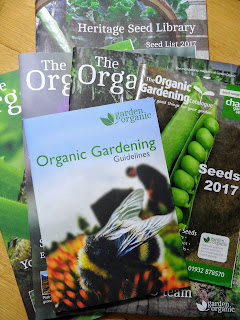It was a busy January, with indoor seed sowing and sadly some seeds just not viable for growth!
I am not one to be disheartened by this; made a list and a visit planned for the Nursery and my local Seed company.
 |
| A sad looking corner in the Propagator |
Seeds which had germinated successfully during the month of January; are all growing healthily indoors.
Care for seedlings:
When it comes to watering, the water used is always the left over (previously boiled) water from the kettle; which is kept in a bottle, near/on a radiator, therefore the water used is always warm or at room temperature and not cold. This helps, not to shock the tender seedlings and seeds during this cool time of the year.
Only the germinating seeds are getting the time under the grow lights. Once germinated, they are moved into unheated propagators around the house therefore growth is slow but healthy.
 |
| Aubergine, Chilli & Sweet Peppers |
The Sweet pea experiment I start on 11th January, where seeds were soaked for 48hrs, gave 0% germination, I made a decision, ditched them on the compost heap and started afresh. I will not give up!
This time, after several discussions on Facebook with other gardeners on: UK Here We Grow, some suggested, to nip the seeds slightly, others have used sand paper to gently break the seed’s thick covering.
Listening to all the advice/practices, I decided to nip the seeds on 27th January, and planted 4-5 seeds per pot in compost mixed with perlite.
 |
| nipped sweet peas |
5 days later (1st February), I noticed growth in the own saved Sweet Pea seeds, and have also noticed in other pots the seeds are swollen, so hopefully growth is imminent.
 |
| Growth on Sweet Peas in 5 days |
 |
| Parsnip Seeds: Hollow Crown & Arrow |
The next stubborn seed I am starting off early is Parsnip. I had no success last year, when I planted them straight into the soil outdoors. (Our allotment site only got flooded 4 times during last summer!!). Parsnips require a longer growing season too, I am starting them indoors on a damp paper towel until germination occurs, hopefully in a few days, then carefully plant them, individually, in cardboard tubes (saved from paper towel and toilet rolls) with compost, with any luck plant them straight into the well prepared soil, end of March, so as not to disturb the roots. During the month of March, more parsnip seeds will be sown straight to the ground, I am hoping to get a crop this year, be it even a small one.
By end of February, the seedlings growing indoors (at home), should be strong enough to carry on growing in the unheated greenhouse, as I do hope the weather will start warming up by the beginning of March.
 |
| Organic Gardening Guidelines |
But before any plants are transferred to the greenhouse, a thorough and deep clean of the Green house is always advised, this clean could be done in the Autumn, but prefer to do it in just before spring. I always use an Organic Greenhouse disinfectant, like Citrox, to clean the Greenhouse.
As for using Fumigator smoke, as well as, a good clean, I am unsure if it is considered organic, therefore will seek advise from Ryton Gardens: Garden Organic, if these fumigating products are ethical for organic growing. There is no mention in their guidelines, but my gut feeling is it is not organic. Therefore to help fight aphids, spider mites and other greenhouse bugs I shall be planting Companion Plants.
February is my month to get these companion plant seeds going, before the green house starts getting filled with vegetable plants, these companion plants will help to deter the bugs and slugs. Popular flower companion plants are Marigolds, Tagetes, Nasturtiums and Calendula are a few to mention. My absolute favourite is Heritage Borage,(seeds which my friend Rob, kindly gave me 2 years ago), to my collection, I am adding the white flower variety of Borage too, called Borago Officinalis ‘Alba’.
This year on the allotment I would like to add more herbs to my collections of mint, rosemary, thyme and sage. I bought quite a few seed packets so these will not only get used for culinary purposes but when planted near the vegetables help keep pests away too, and also invite more bees and other pollinating insects.
An example of a helpful herb: Mint, when grown near the Brassicas (cabbage family plants) can help deter the Cabbage White (butterfly).
 |
| Seed sowing continues: Companion plants & Herbs |
These are just some of my gardening jobs for this month, what exciting plans have you for February?

